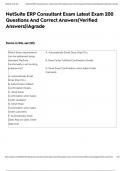Tentamen (uitwerkingen)
HBS Harvard Business School HBX Core Financial Accounting 2024 Exam Review Questions and Answers 100% Pass | Graded A+
- Vak
- Instelling
HBS Harvard Business School HBX Core Financial Accounting 2024 Exam Review Questions and Answers 100% Pass | Graded A+
[Meer zien]






